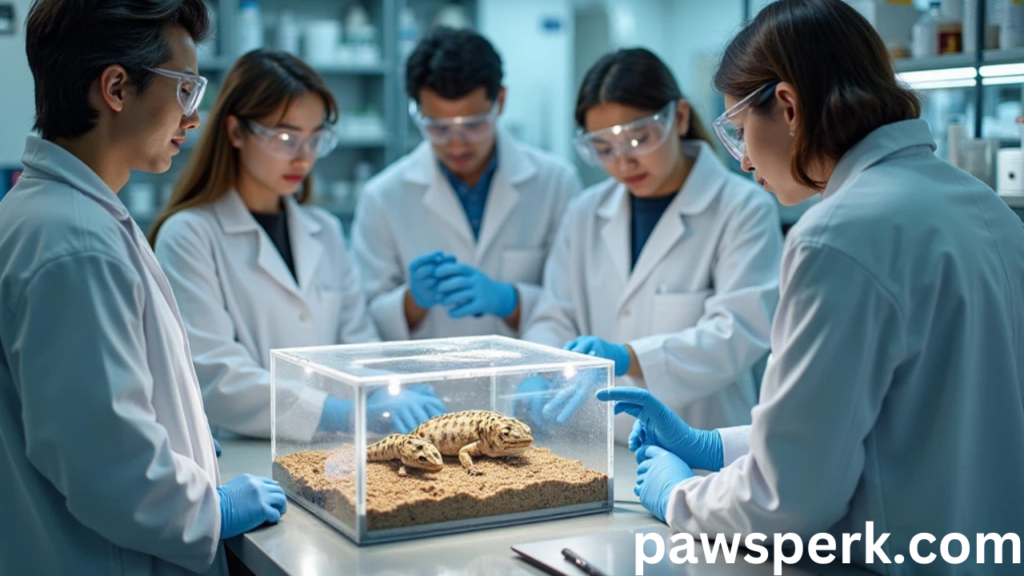“Afghan Leopard Geckos’ health and welfare depend on the substrate you choose. Your pet can engage in activities like burrowing and exploring because the substrate not only gives them a pleasant surface but also replicates their natural habitat. This blog post will discuss several substrate choices, their advantages and disadvantages, and advice for keeping your gecko in a healthy habitat.”
Understanding Leopard Gecko Habitat
Afghan leopard geckos naturally inhabit arid regions with packed earth, sandy substrates, and occasional rocky areas. These unique environmental conditions significantly influence the gecko’s natural behaviors, such as burrowing, climbing, and basking in the sun’s warmth. The landscape of their native environment also affects essential physiological needs like temperature regulation, hydration, and digestion. Understanding these factors helps you create an environment that closely mirrors the gecko’s wild habitat, which, in turn, promotes its health and well-being in captivity.
To replicate this desert-like habitat in your home, you must select the right substrate. The appropriate substrate not only mimics the texture and temperature of the gecko’s natural surroundings but also supports its overall health by maintaining the proper humidity and temperature. By carefully choosing the ideal substrate, you provide your Afghan leopard gecko with a comfortable, safe, and stimulating environment that encourages natural behaviors, reduces stress, and enhances its quality of life
Ideal Substrate Options
- Sand-Soil Mixture: Untreated topsoil and sand are a common combination among reptile aficionados. 50% topsoil to 50% pre-washed, dust-free play sand is the suggested ratio. This mixture preserves moisture levels necessary for shedding and general health while permitting digging.
- Excavator Clay: Another excellent option is excavator clay, which can be mixed with sand or used alone. This substrate can hold burrows well and provides a stable environment for your gecko to dig and explore.
- Bioactive Substrates: For those looking to create a more naturalistic setup, bioactive substrates are an innovative choice. These setups incorporate live plants and beneficial microorganisms that help break down waste, creating a self-sustaining ecosystem. They can drastically lower maintenance over time, even if they need more initial setup.
- Slate tiles or reptile carpet: Solid solutions like slate tiles or reptile carpet are safe substitutes if you’re worried about the dangers of loose surfaces. If consumed, they do not provide any risk of impaction and are simple to clean. They might not, however, offer the enrichment that loose substrates do.
Substrates to Avoid
While there are many suitable substrates, some should be avoided due to health risks:
- Calci-Sand: This type of sand can cause impaction if ingested and is not recommended for leopard geckos.
- Coconut Fiber (Eco Earth): While it may seem like a natural choice, coconut fiber can be dusty when dry and may expand when wet, leading to potential impaction issues.
- Wood Chips or Bark: These materials can pose choking hazards and are unsuitable for leopard geckos due to their tendency to ingest them while feeding or exploring.

Maintaining Your Gecko’s Substrate
Maintaining your leopard gecko properly is essential after selecting the appropriate substrate:
- Spot Cleaning: To stop bacteria from growing, regularly clear the substrate of debris and uneaten food. Daily spot cleaning is recommended.
- Full Change-Out: Depending on the type of substrate used, a complete change-out may be necessary every few months. For bioactive setups, this may be less frequent due to the natural decomposition processes at play.
- Keeping an eye on humidity levels: Make sure the substrate keeps the right amount of humidity for the health of your gecko. Fungal infections or respiratory problems might result from excessive moisture.
- Temperature Regulation: For the best digestion and overall health, leopard geckos need a temperature gradient in their habitat. Make sure that the substrate allows for heat retention in basking areas while providing cooler spots as well.
You may also like: Banana Ball Pythons: Everything You Need to Know About This Stunning Morph
Conclusion
To provide your Afghan leopard gecko with a cozy, safe, and stimulating environment that closely mirrors its natural habitat, you must select the right substrate. The right substrate choice not only enhances your gecko’s physical environment but also supports its mental and emotional well-being. A combination of sand and soil or a bioactive substrate works well to recreate the gecko’s native surroundings, offering the right texture for burrowing, proper humidity control, and stimulation for natural behaviors. These substrates allow your pet to stay active and engaged while promoting overall health.
Choosing safe, non-toxic materials ensures your gecko’s safety and happiness. By avoiding dangerous substrates and following the proper care guidelines, you create a thriving habitat that reduces stress and encourages natural behaviors. Regular maintenance, such as cleaning and replacing the substrate as needed, ensures a hygienic and comfortable environment for your gecko.
Beyond providing the ideal physical environment, interacting with and caring for your gecko’s surroundings helps you deepen the bond between you and your pet. By carefully considering your substrate options and consistently practicing good care routines, you design a perfect living space that promotes your gecko’s health, happiness, and well-being. This thoughtful approach leads to a rewarding and enriching relationship between you and your cherished reptile.


